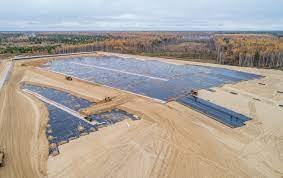Geomembranes are essential components in various engineering and environmental applications, offering impermeable barriers to prevent the seepage or leakage of liquids and gases. They are synthetic membranes manufactured from polymers and are extensively used in containment systems for waste management, water conservation, and hazardous material storage. Let’s delve into what geomembranes are, their types, applications, and the significance they hold in modern infrastructure projects.
What is Geomembrane?
what is a geomembrane refers to a synthetic membrane or liner primarily used as an impermeable barrier in geotechnical and environmental engineering applications. These membranes are manufactured from various polymeric materials such as high-density polyethylene (HDPE), low-density polyethylene (LDPE), polyvinyl chloride (PVC), ethylene propylene diene monomer (EPDM), and chlorosulfonated polyethylene (CSPE).
Types of Geomembranes
1. High-Density Polyethylene (HDPE) Geomembranes
HDPE geomembranes are among the most widely used due to their excellent chemical resistance, durability, and flexibility. They are commonly utilized in landfill liners, pond liners, and mining applications.
2. Low-Density Polyethylene (LDPE) Geomembranes
LDPE geomembranes offer good flexibility and elongation properties, making them suitable for applications requiring conformability. They are often used in canal lining, secondary containment, and vapor barriers.
3. Polyvinyl Chloride (PVC) Geomembranes
PVC geomembranes exhibit superior resistance to UV radiation and chemical degradation, making them ideal for exposed applications such as floating covers, decorative ponds, and landfill caps.
4. Ethylene Propylene Diene Monomer (EPDM) Geomembranes
EPDM geomembranes possess excellent weathering resistance and elasticity, making them suitable for applications requiring high elongation and durability, such as pond liners and roof membranes.
5. Chlorosulfonated Polyethylene (CSPE) Geomembranes
CSPE geomembranes offer superior chemical resistance and weatherability, making them suitable for applications involving exposure to harsh environments, such as hazardous waste containment and oil field lining.
Applications of Geomembranes
Geomembranes find extensive applications in various sectors due to their versatility and effectiveness in providing containment solutions. Some common applications include:
Environmental Protection
Geomembranes are widely used in environmental protection projects such as landfill liners, leachate ponds, and groundwater protection systems to prevent the contamination of soil and water resources by hazardous substances.
Water Conservation
In water conservation projects, geomembranes are utilized in reservoir lining, canal lining, and irrigation ponds to reduce seepage losses and optimize water storage capacity, thereby enhancing water resource management efficiency.
Mining Industry
Geomembranes play a crucial role in the mining industry for applications such as heap leach pads, tailings dams, and acid mine drainage containment, where they help mitigate environmental impacts and ensure regulatory compliance.
Agriculture
In agriculture, geomembranes are used for applications such as pond liners, silage pits, and wastewater treatment lagoons to facilitate efficient water storage, nutrient management, and pollution control, thereby supporting sustainable farming practices.
Civil Engineering
Geomembranes are integral to civil engineering projects such as tunnel waterproofing, bridge abutment protection, and slope stabilization, where they provide durable and cost-effective solutions for preventing water infiltration and soil erosion.
Significance of Geomembranes in Modern Infrastructure Projects
The widespread adoption of geomembranes in modern infrastructure projects can be attributed to several key factors:
- Environmental Protection: Geomembranes help prevent the migration of contaminants into the surrounding environment, safeguarding ecosystems and public health.
- Resource Conservation: By minimizing seepage losses and optimizing water storage, geomembranes contribute to efficient water resource management and conservation.
- Risk Mitigation: Geomembranes reduce the risk of environmental liabilities associated with the improper containment of hazardous substances, thereby ensuring regulatory compliance and minimizing legal liabilities.
- Long-Term Performance: Geomembranes offer long-term durability and reliability, providing sustainable solutions for infrastructure projects with extended service life requirements.
- Versatility: With a wide range of material options and installation methods, geomembranes can be tailored to meet the specific requirements of diverse applications, from landfill liners to decorative pond liners.
In conclusion, geomembranes play a critical role in modern engineering and environmental projects, offering effective containment solutions to address various challenges related to waste management, water conservation, and environmental protection. As the demand for sustainable infrastructure solutions continues to grow, the importance of geomembranes in ensuring the integrity and longevity of civil engineering and environmental protection projects will remain paramount.

